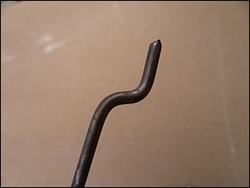The design of the GWCT breakaway snare is free for manufacturers to copy, but regrettably GWCT cannot police the market to ensure that snares purporting to be the GWCT breakaway snare meet the published specifications. We will endeavour to list here known quality issues and improvements, as these come to our attention. It is the responsibility of the person operating a snare to ensure that it complies with the law and with the recommendations of the relevant Code of Practice. If you want to be sure the snare will give the performance documented for the GWCT breakaway snare, here are some details to look out for. We will also document changes that we see as distinct improvements on the original design (see bottom of page).
Crimps
Whatever crimps are used, they must be consistently stronger than the weak link at the noose. Brass crimps have been found to fracture during crimping, leading to crimp failure in use. Copper crimps are strongest and nicely inconspicuous once weathered.
Cable ends should not protrude from crimps, because this is a known cause of mouth injuries in captured animals.
Running eye
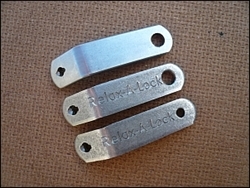 We have seen some ‘pirate’ running eyes copying the Kaatz Bros Relax-A-Lock. The pirate version, which looked superficially identical but without the Relax-A-Lock model name stamped on the face, was self-locking in use.
We have seen some ‘pirate’ running eyes copying the Kaatz Bros Relax-A-Lock. The pirate version, which looked superficially identical but without the Relax-A-Lock model name stamped on the face, was self-locking in use.
The copy (top) proved to be self-locking when built into snares. Note that the Relax-A-Lock in the middle (from the original GWCT design) has had the hole in the fixed end enlarged; this is correct for use with a titanium split-ring but is unnecessary with the steel ring.
Breakaway clip
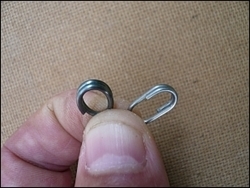 In our documented field trials, we used a titanium clip with nominal 80lb breaking strain. The high quality and consistency of these allowed us to demonstrate proof-of-concept, but they were expensive and manufacturers have had difficulty obtaining them. In commercial versions of our snare, stainless steel clips (pictured right) are being used as a much cheaper alternative. In laboratory break-tests, these clips have similar strength to the (nominal) 80lb titanium rings, and early feedback from operators suggests that they are a satisfactory alternative. This component may need further refinement. Meanwhile purchasers should bear in mind that snares with steel breakaways are not exactly what was tested in GWCT research.
In our documented field trials, we used a titanium clip with nominal 80lb breaking strain. The high quality and consistency of these allowed us to demonstrate proof-of-concept, but they were expensive and manufacturers have had difficulty obtaining them. In commercial versions of our snare, stainless steel clips (pictured right) are being used as a much cheaper alternative. In laboratory break-tests, these clips have similar strength to the (nominal) 80lb titanium rings, and early feedback from operators suggests that they are a satisfactory alternative. This component may need further refinement. Meanwhile purchasers should bear in mind that snares with steel breakaways are not exactly what was tested in GWCT research.
Anchor attachment
D-shackles should always be tightened with pliers. Some poor quality D-shackles are so soft that it is easy to over-tighten them, stripping the thread. It is possible for a single D-shackle to jam against the top of the anchor stake. We recommend the use of two interconnected D-rings, which act as a universal joint.
Stop position
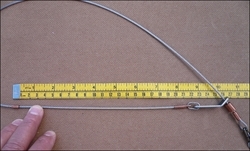 Some variation in manufacture is expected, but we would expect no more than 5mm variation either side of the mark (we advise 26cm). We suggest you check the stop-lengths on a sample of the snares you buy. If they are wrong, report the problem to your supplier, because in the past, some have measured stop-length incorrectly. The measurement to be made is the distance from the anchor side of the stop, including the breakaway link and the Relax-A-Lock, to the aperture through which the snare cable runs.
Some variation in manufacture is expected, but we would expect no more than 5mm variation either side of the mark (we advise 26cm). We suggest you check the stop-lengths on a sample of the snares you buy. If they are wrong, report the problem to your supplier, because in the past, some have measured stop-length incorrectly. The measurement to be made is the distance from the anchor side of the stop, including the breakaway link and the Relax-A-Lock, to the aperture through which the snare cable runs.
Swivels
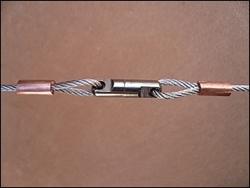 Like crimps, swivels need to exceed the break strain of the breakaway ring by a generous margin. We suggest a minimum breaking strain of 300lbs. Mid-point swivels need to be strong but small, so that they are inconspicuous. Most steel swivels similar in size to those specified for our snare (technical specifications) are amply strong. Brass swivels are inadequate because they will not withstand the fretting action of the cable.
Like crimps, swivels need to exceed the break strain of the breakaway ring by a generous margin. We suggest a minimum breaking strain of 300lbs. Mid-point swivels need to be strong but small, so that they are inconspicuous. Most steel swivels similar in size to those specified for our snare (technical specifications) are amply strong. Brass swivels are inadequate because they will not withstand the fretting action of the cable.
Mid-line swivels need to be inconspicuous but strong, like the pictured steel 'Aussie' swivel.
Tealers
3mm fencing wire is much cheaper than copper, but much harder to bend into position, does not blend in so well, and if forgotten presents a greater hazard to farm machinery. Unlike softer copper, a sharp-ending length of stiff wire protruding above ground level creates a potential hazard for captured animals, especially hares.
Tealer clips
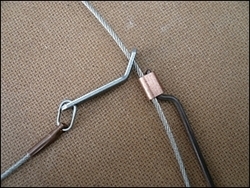 Various clips may be used to attach the snare to the tealer, but the snare should detach from the tealer when a capture occurs. It is advantageous if the clip ‘revolves’ around the tealer, so that the snare can drop back into position if a non-target species - e.g. a pheasant - brushes underneath it.
Various clips may be used to attach the snare to the tealer, but the snare should detach from the tealer when a capture occurs. It is advantageous if the clip ‘revolves’ around the tealer, so that the snare can drop back into position if a non-target species - e.g. a pheasant - brushes underneath it.
A broad copper tealer clip slips neatly over the end of the tealer, swivels freely, and disengages when a capture is made.
Possible improvements
Minimum loop stop
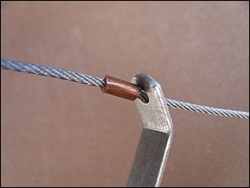 We have seen the minimum loop stop replaced by a 7mm single-barrelled copper crimp, as pictured on the right. This is stronger, and in our opinion an improvement on the original design.
We have seen the minimum loop stop replaced by a 7mm single-barrelled copper crimp, as pictured on the right. This is stronger, and in our opinion an improvement on the original design.
Tealer end design
The original GWCT design had a stop fixed onto the copper tealer to prevent the tealer clip on the snare slipping down the tealer. A cranked end to the tealer achieves the same result much more simply, and allows the snare to pivot back into position if brushed aside by deer, pheasants, etc.
